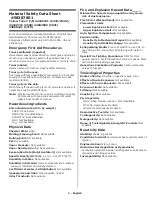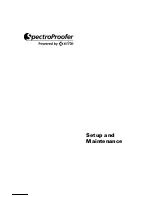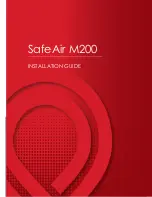
6/10/13 – 11
9
Rescue with the Rope Wrench
The Rope Wrench may be used as a tool both by
rescuers as well as by victims of accidents at height.
Use by a rescuer.
The rope wrench provides
additional friction to the system and allows a
friction hitch to work. It is not designed for heavy
loads or high speeds. If the rescuer is performing
a pickoff while on a single line then additional
friction besides a rope wrench should be
employed. If the Rescuer is using double rope
technique, than a rope wrench can be added to
the system to provide additional friction to the
system.
Use by a victim.
The cause of the accident must first
be understood. Depending on the scenario,
different options are available. For example, if the
climber has been using a basal anchor, he may
be lowered to the ground by using the climber’s
rope. The lowering system should be well thought
out and secure. Use backups so that if the belayer
loses grip on the rope there will be a backup.
Aerial Rescue.
It may not be possible to lower the
climber using a basal anchor. Depending on the
incident, the climber’s system may not function. If
there has been a large fall, the hitch may be tight
to the line and the hitch cord may even be
damaged. In these cases, lifting the injured
climber and transferring him to an alternate
system may be the best course. To lift an injured
climber, a 3:1 system like the one demonstrated in
Figure 8
can be used to create mechanical
advantage allowing the victim to be lifted with less
exertion. If through inspection the climber’s
system is still intact, then the injured climber may
be lowered using his/her own system.
Equipment Maintenance and Inspections
Pre-Climb Inspections
Before each and every use of the Rope Wrench System,
all components should be inspected for damage, wear,
and compatibility with the present situation. Never use
any piece of equipment that does not pass all
inspections listed below.
Standard Equipment Inspections
1.
Ropes.
Each rope (particularly the climbing rope,
friction hitch, and tether) should be inspected for
anything that makes the rope appear non-uniform,
including:
Soft spots:
areas that seem prone to bending.
Hourglassing:
areas where the outside of the
rope seems to have collapsed in on itself.
Boogers
: frayed, cut, or rough areas.
Puffs:
rope fibers sticking out of the rope
excessively.
Glazing
: melted or burned areas.
Note: these are not necessarily industry standard
terms.
The rope should be inspected not only visually but
also physically, with an ungloved hand. Touch can
sense changes in stiffness and texture that vision
cannot.
Be sure all ropes were stored in a clean, dry, non-
corrosive environment (or acceptable environment
per the manufacturer’s specifications.) Leaving a
rope in an adverse environment for longer than the
time required to perform the necessary tree work
could cause it to be invisibly weakened and should
not be used.
2.
Carabiners, Pulleys, and Ascenders.
Each of
these devices will be slightly different depending on
the choices of the climber. As such, they will all
have their own set of inspections to be made.
Follow these general guidelines:
1.
Always begin by consulting the instructions or
owner’s manual for that particular device.
2.
Operate the device several times to verify
proper operation (for example, for the carabiner,
unlock, open, and let it close.)
3.
Check for burrs or sharp edges.
3.
Harness.
Each harness will be different depending
on the choice of the climber. Consult the harness’s
instructions or owner’s manual for directions
regarding pre-climb inspections.
Rope Wrench Specific Inspections
1.
Inspect the
entire device
for burrs or sharp edges
that may have developed through use or during
storage.
2.
Visually check the
Slic Pin
to ensure the spring-
loaded tab is sticking out and keeping the Slic Pin
from moving.
3.
Attempt to pull the
Slic Pin
out to ensure the spring-
loaded tab will not allow it to come out.





























